child restraint AUDI A7 2018 Owners Manual
[x] Cancel search | Manufacturer: AUDI, Model Year: 2018, Model line: A7, Model: AUDI A7 2018Pages: 274, PDF Size: 42.77 MB
Page 51 of 274
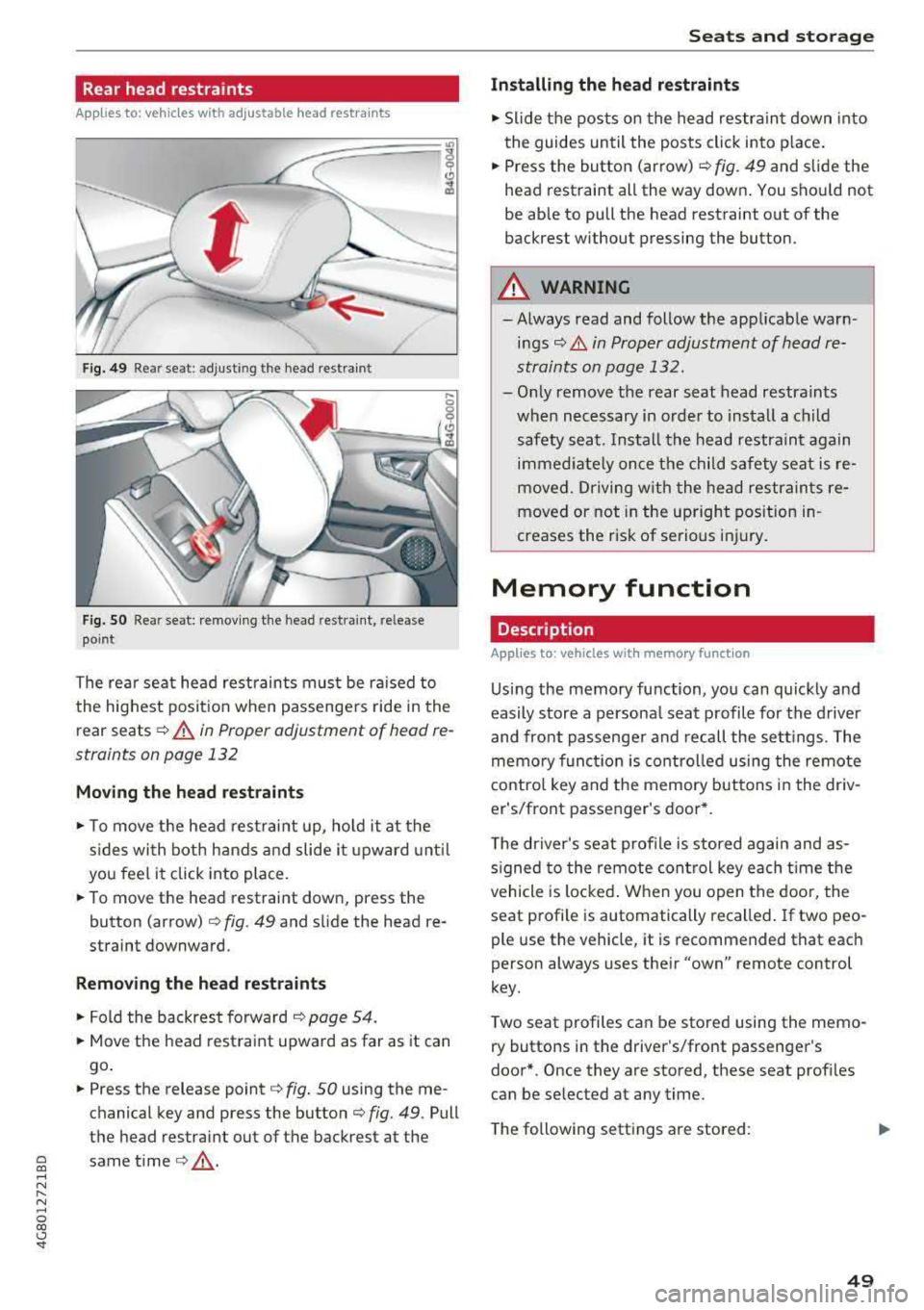
Rear head restraints
Applies to: vehicles with adjustable head restra ints
Fig. 49 Rear seat: adjusting the head restraint
Fig. SO Rear seat: remov ing the head restra int, release
point
The rear seat head restraints must be ra ised to
the highest posit ion when passengers ride in the
rear seats
¢ .&. in Proper adjustment of head re
straints on page 132
Moving the head rest raints
.,. To move the head restraint up, ho ld it at the
s ides with both hands a nd slide i t upward unt il
you feel it click into place.
.. To move the head restraint down, press the
button (arrow) ¢
fig. 49 and slide the head re
straint downward.
Remov ing th e head re stra ints
.,. Fold the backrest forward ¢ page 54.
.. Move the head restraint upward as far as it can
go .
.,. Press the release point¢ fig. 50 using the me
chanical key and press the
button¢ fig. 49. Pull
the head restraint out of the backrest at the
~ same time¢ _&. ,...,
N
" N ,...,
0 00 <.,;) '
Installing the head re straints
.,. Slide t he pos ts on the head restraint down into
the guides until the posts click into p lace .
.. Press the button (arrow) ¢ fig. 49 and slide the
head restraint all the way down . You should not
be able to pull the head restraint out of the
backrest without pressing the button.
A WARNING
-Always read and follow the applicable warn
ings¢ & in Proper adjustment of head re
straints on page 132.
-Only remove the rear seat head restraints
when necessary in order to install a ch ild
safety seat. Ins tall the head restraint again
immed iate ly once the child safety seat is re
moved. Driving w ith the head restrain ts re
moved or not in the upright position in
creases the risk of serious in jury.
Memory function
Description
Applies to: vehicles with memory function
Us ing the memory function, you can quickly and
easily store a persona l seat profile for the driver
and front passenger and recall the sett ings. The
memo ry funct ion is contro lled using the remote
contro l key and the memory buttons in the dr iv
er's/front passenger's door* .
T he driver's seat profile is stored again and as
s igned to the remote cont rol key each t ime the
vehicle is locked . When you open the door, the
seat profile is automatically recalled . If two peo
ple use the vehicle, it is recommended that each
person always uses their
"own" remote control
key .
Two seat profiles can be stored using the memo ry buttons in the driver's/front passenger's
door*. Once they are stored, these seat prof iles
can be selected at any time.
The following settings are stored:
.,.
49
Page 131 of 274
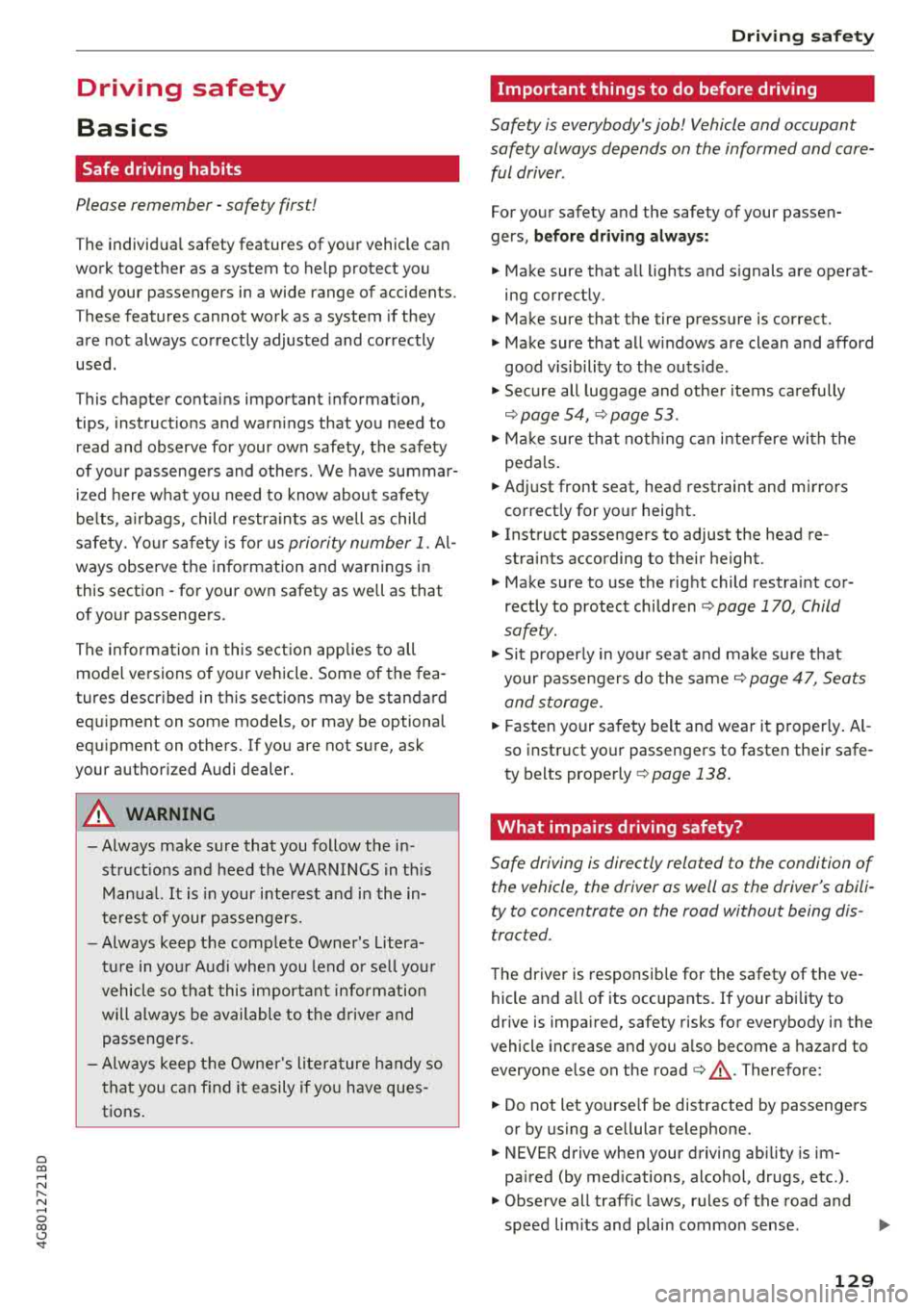
a co .... N
" N .... 0 00 \.J '
Basics
Safe driving habits
Please remember -safety first!
The individua l safety features of your vehicle can
work together as a system to help protect you
and your passengers in a wide range of accidents.
These features cannot work as a system if they
are not always correctly adjusted and correctly
used .
This chapter contains important informat ion,
tips, instruct ions and warn ings that you need to
read and observe for your own safety, the safety
of your passengers and others . We have summar
i zed here what you need to know about safety
be lts, a irbags, child restra ints as well as child
safety. Yo ur safety is for us priority number 1. Al
ways observe the information and warnings in
this section - for your own safety as well as that
of your passengers.
The informa tion in t his sect ion app lies to all
model versions of your vehicle. Some of the fea
tures described in this sections may be standard
eq uipment on some models, or may be optional
equ ipment on others. If you are not sure, ask
your author ized Audi dealer.
A WARNING
-Always make sure that you follow the in
struct ions and heed the WARNINGS in th is
Manual. It is in your i nterest a nd in the in
te rest of your passengers .
-
-Always keep the complete Owner's Litera
t ur e in yo ur Audi whe n you lend or se ll yo ur
vehicle so that this important information
w ill a lways be available to the d rive r and
passengers.
-Always keep the Owne r's literature h andy so
that you can f ind it easily if yo u have ques
tions .
Driving saf ety
Important things to do before driving
Safety is everybody 's job ! Vehicle and occupant
safety always depends on the informed and care
ful driver .
For your safety and the safety of your passen
gers,
befor e dri ving alw ays:
.. Make sure that a ll lights and signals are operat
ing correctly.
.. Make sure tha t the tire pressure is correct .
.. Make sure that all windows are clean and afford
good vis ibility to the outs ide .
.. Secure all luggage and othe r items ca refully
¢ page 54, ¢page 53 .
.. Make sure that not hing c an interfere wi th the
peda ls .
.. Adjust front seat, head restraint and mirrors
correct ly for your height.
.. Instruct passengers to adjust the head re
straints according to their height.
.. Make sure to use the rig ht child restra int cor
rectly to protect children
¢ page 170, Child
safety .
.. Sit properly in your seat and make sure t hat
your passengers do the
same ¢ page 47, Seats
and storage.
.. Fasten your safety belt and wear it properly . Al
so instruct your passengers to fasten their safe
ty belts
properly ¢ page 138 .
What impairs driving safety?
Safe driving is directly related to the condition of
the vehicle , the driver as well as the driver 's abili
ty to concentrate on the road without being dis
tracted.
The driver is responsib le for the safety of the ve
hicle and a ll of its occupants. If your ability to
drive is impa ired, safety risks for everybody in the
vehicle increase and you a lso become a hazard to
everyone else on the road
¢ &_ . Therefore:
.. Do not let yourse lf be distracted by passengers
or by using a cellular telephone .
.. NEVER drive when your driving abi lity is im
pa ired (by med ications, alcohol, drugs, etc .) .
.. Observe all traffic laws, rules of the road and
speed lim its and plain common sense .
129
Page 133 of 274

a co .... N
" N .... 0 00 \,;J '
face decreases the ability of the supplemen
tal driver's airbag to protect you in a colli sion .
- Always sit in an upright position and never
lean against or place any part of your body
too close to the area where the airbags are
located .
- Before driving, always adjust the front seats
properly and make sure that all passengers
are properly restrained .
- For adjustable head restraints : before driv
ing, always also adjust the head restraints
properly .
- Never adjust the seats while the vehicle is moving . Your seat may move unexpectedly
and you could lose control of the vehicle.
- Never drive with the backrest reclined or
tilted far back! The farther the backrests are
tilted back, the greater the risk of injury due
to incorrect positioning of the safety belt
and improper seating position.
- Children must always ride in child seats
~ page 170. Special precautions apply
when installing a child seat on the front
passenger seat
i::> page 146 .
Proper seating position for the front
passenger
The proper front passenger seating position is
important for safe, r elaxed driving.
For your own safety and to reduce the risk of in
jury in the event of an accident, we recommend that you adjust th e seat for the front passenger
to the following position:
.. Adjust the angle of the seatback so that it is in
an upright position and your back comes in full
contact with it wh enever the vehicle is moving.
.. For adjustable head restraints: adjust the head
restraint so the upper edge is as even as possi
ble with the top of your head. If that is not pos
sible , try to adjust the head restraint so that it
is as close to this position as possible
~ page 132. Move the head restraint so that it
is as close to the back of the head as possible.
Driving safety
.. Keep both feet flat on the floor in front of the
front passeng er seat.
.. Fasten and wear safety belts correctly
i::> page 141 .
For detailed information on how to adjust the
front pass enger's s eat, see
i::> pag e 47.
A WARNING
= -
Front seat passengers who are unbelted, out
of position or too close to the airbag can be
seriously injured or killed by the airbag as it
unfolds . To help reduce the risk of serious
personal injury:
- Passengers must always sit in an upright po
sition and never lean against or place any part of their body too close to the area
where the airbags are located.
- Passengers who are unbelted, out of posi
tion or too close to the airbag can be seri
ously injured by an airbag as it unfolds with
g reat force in the blink of an eye.
- Always make sure that there are at least
10 inches (25 cm) between the front pas
senger's breastbone and the instrument panel.
- Always make sure that there are at least
4 inches (10 cm) between the front passen
ger's knees and the lower part of the instru
ment panel.
- Each passenger must always sit on a seat of
their own and properly fasten and wear the
safety belt belonging to that seat .
- Before driving, always adjust the front pas
senger seat properly.
- For adjustable head restraints: before driv
ing, always also adjust the head restraints
properly .
- Always keep your feet on the floor in front
of the seat. Never rest them on the seat, in
strument panel, out of the window, etc. The
airbag system and safety belt will not be
able to protect you properly and can even in
crease the risk of injury in a crash .
- Never drive with the backrest reclined or
tilted far back! The farther the backrests are
tilted back, the greater the risk of injury due
~
131
Page 134 of 274
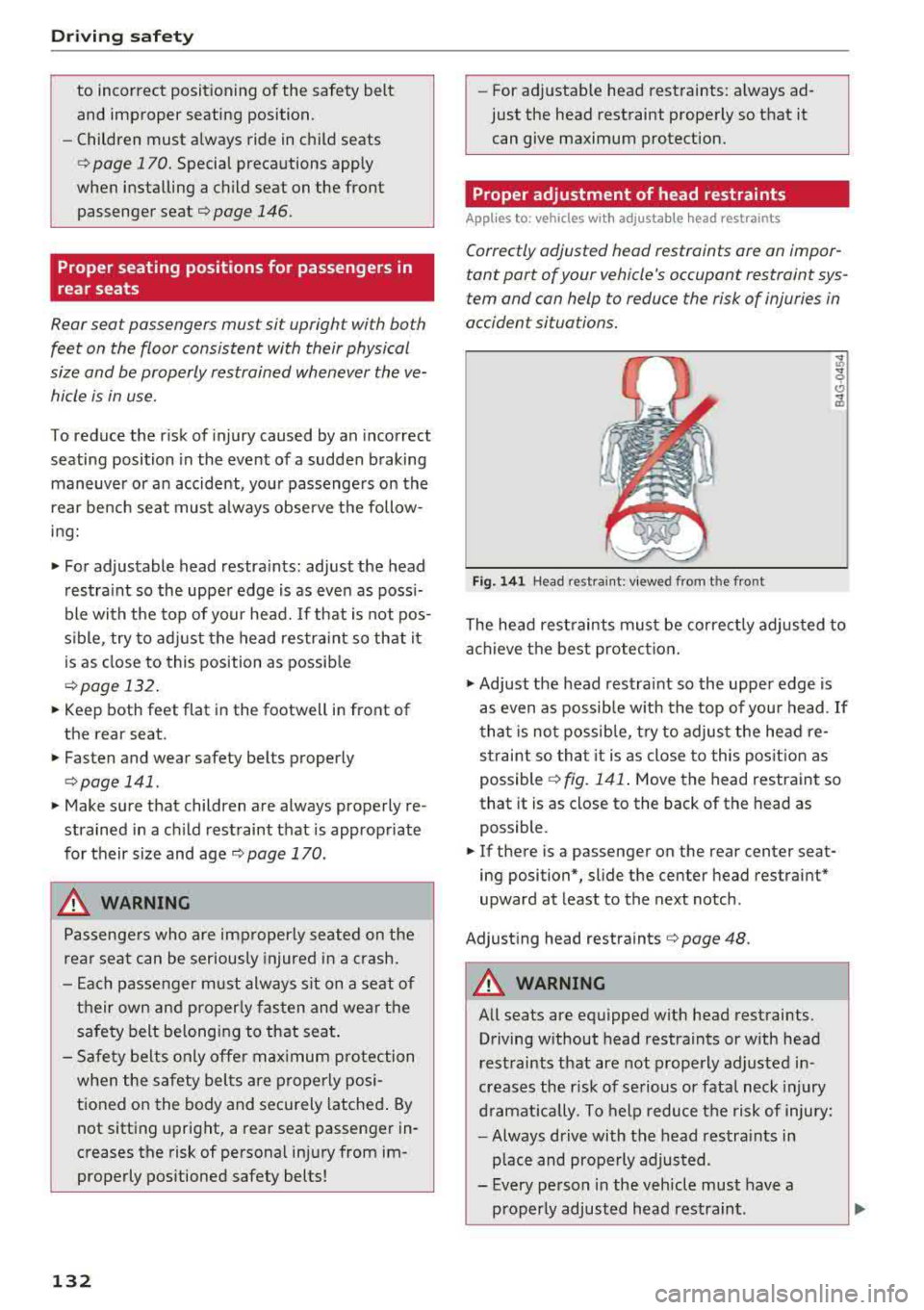
Driving safety
to incorrect positioning of the safety belt
and improper seating position.
- Children must always ride in child seats
c:> page 170. Special precautions apply
when installing a child seat on the front passenger seat
c:> page 146 .
Proper seating positions for passengers in
rear seats
Rear sea t passengers must si t upright wi th both
feet on the floor consistent with their physical
size and be properly restrained whenever the
ve
hicle is in use.
To reduce the r isk of injury caused by an incorrect
seating position in the event of a sudden braking
maneuver or an accident, yo ur passengers on the
rear bench seat must always observe the follow
i n g:
• For adjustable head restra ints: adjust the head
r estra int so the uppe r edge is as even as poss i
ble with the top of your head. If that is not pos
sible, try to ad just the head restra int so th at it
is as close to this position as possib le
c:> page 132 .
• Keep both feet flat i n the footwell i n front of
the rear seat.
• Fas ten and wear safety belts properly
c:> page 141.
• Make sure that children are always properly re
strained in a ch ild restraint that is approp riate
for their size and age
c::> page 170 .
_& WARNING
Passengers who are imp roperly seated on the
rear seat can be seriously injured in a crash .
- E ach passenger m ust always sit on a seat o f
their own an d properly fas ten and we ar the
safe ty belt belongi ng to that sea t.
- Safe ty belts only offe r m aximum p rotection
when the safety belts are properly posi
tioned on the body and securely latched . By
not sitting upright, a rear seat passenger
in
c reases the risk of personal in ju ry from im
properly positioned safety belts!
132
- For adjustable head restraints: always ad
just the head restraint properly so that it
can give maximum protection.
Proper adjustment of head restraints
App lies to : vehicles with adjustable head restra ints
Correctly adjusted head restraints are an impor
tant part of your vehicle's occupant restraint sys
tem and can help to reduce the risk of injuries in
acciden t situations.
Fig. 141 Head rest ra in t: v iewed from t he front
The head rest raints must be corre ctly adjus ted to
a chieve t he best protec tion .
• Adjust the head rest ra int so the upper edge is
as even as possib le w ith the top of you r head . If
t ha t is no t possib le, try to adjus t the head
re
strai nt so that it is as close to this pos it ion as
possible
c:> fig. 141 . Move the head restraint so
that it is as close to the back of the head as
possible .
• If there is a passenger on the rear center seat
ing position*, slide the center head restraint *
upward at least to the next notch .
Adjust ing head restraints
c:> page 48.
_& WARNING
All seats are equipped w ith head restraints .
Driving w ithout head restraints or w ith head
rest raints that are not prope rly adj usted in
creases the r is k of se rious or fata l neck injury
d ramat ica lly . To help reduce t he risk of injury:
- Always drive with the head restra ints in
place and prope rly adjusted.
- Every pe rson in the vehicle must have a
proper ly adjusted head restraint .
-
Page 135 of 274
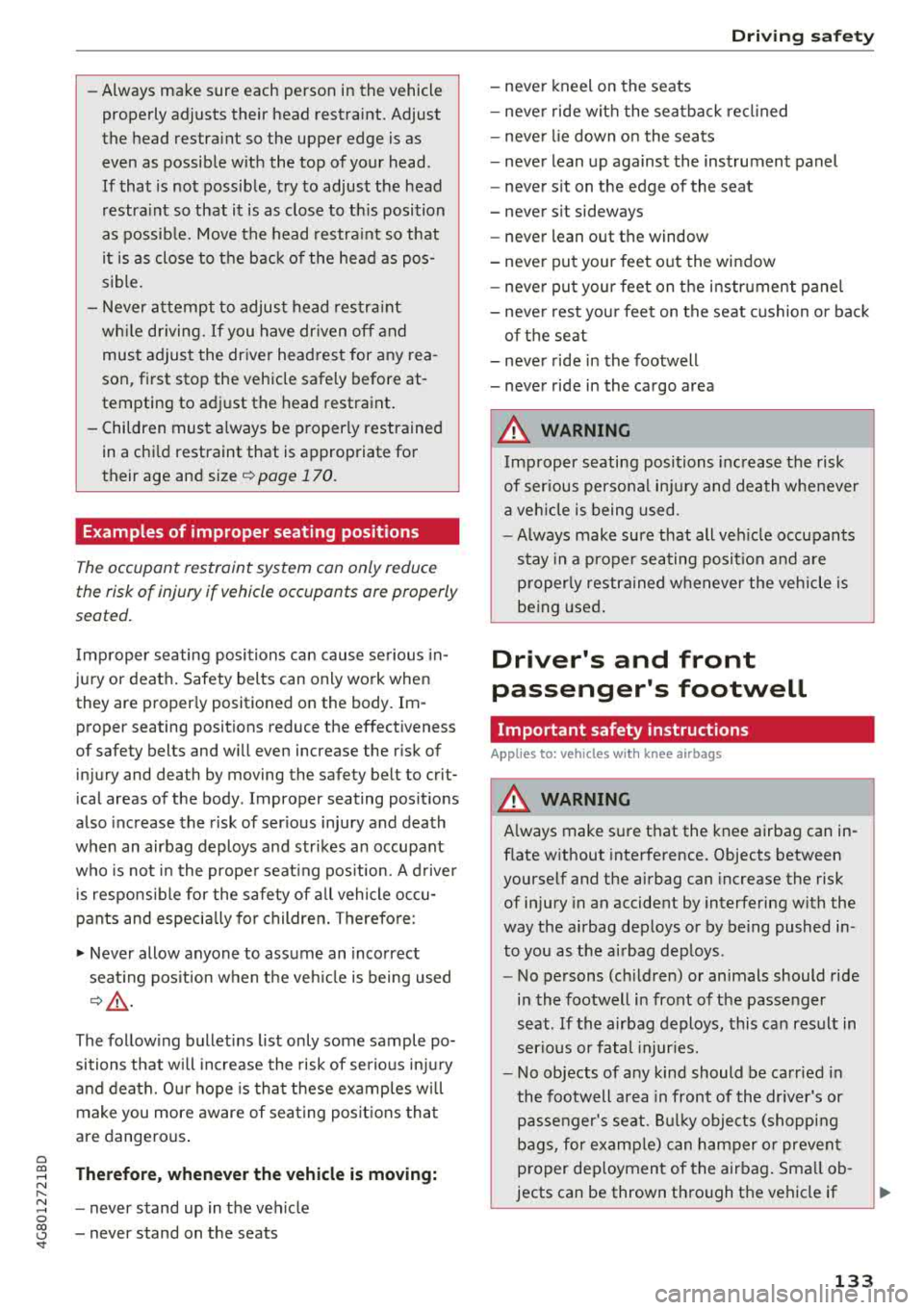
a co .... N
" N .... 0 00 \.J '
properly adjusts their head restraint. Adjust
the head restra int so the upper edge is as
even as possible w ith the top of your head .
If that is not possible, try to adjust the head
restra int so that it is as close to th is position
as possib le. Move the head restra in t so that
it is as close to t he b ack of the he ad as pos
sible.
- Never attempt to adjust head restra int
w hil e d riving. If you have dr iven off and
must adjust the dr ive r headrest for any rea
son, first stop the vehicle safely before at
tempting to adjust the head restraint .
- Children must a lways be proper ly restrained
in a chi ld restraint that is appropriate for
their age and size
~ page 170.
Examples of improper seating positions
Th e occupant r estraint syst em con only r educ e
the risk of injury if vehicle occupants ore properly
seated.
I mp roper seating posi tions can cause se rious in
jury or death . Safety belts can only work when
they ar e properly positioned on the body. Im
prope r seating positions reduce the effectiveness
of safe ty belts and w ill even increase the r isk of
injury and death by moving the s afety belt to crit
ical areas of the body . Improper seating posit ions
also increase the risk of ser ious injury and death
when an airbag deploys and strikes an occupant
who is not i n the prope r seat ing pos ition. A d rive r
i s respons ible for the safety of a ll vehicle occu
pants and especia lly fo r children . There fore:
"' Never allow anyone to assume an inco rrect
seat ing pos it ion w hen t he ve hicle is being used
~& -
The follow ing bulletins list only some sample po
sitions that will increase the risk of serious inju ry
and dea th. O ur hope is that these examp les w ill
make you more aware of seat ing pos it ions tha t
are dangerous .
Therefore, wh enever th e vehicle is moving:
- never stand up in the veh icle
- never stand on the seats
Dri ving saf ety
- never kneel on the seats
- neve r ride wit h the seatback recl ined
- neve r lie down on the seats
- neve r lean up against the instrument panel
- never s it on the edge of the seat
- never s it sideways
- never lean out the window
- never put your feet out the window
- neve r put your feet on t he instr ument pane l
- neve r rest your feet on the seat cushion or back
of the seat
- neve r ride in the footwell
- never ride in the cargo area
A WARNING
-
Imp roper seating positions inc rease the risk
of ser ious perso nal in jury and death whenever
a ve hicl e is being u sed .
- Always make sure that all ve hicle occupants
stay in a p roper seating posit ion and a re
p roperly restra ined whe never the veh icle is
be ing used.
Driver's and front
passenger's footwell
Important safety instructions
Applies to: vehicles with knee airbags
A WARNING
= -
A lways make s ure t hat the knee airbag can in
flate w ithout interference. Objects between
yourself and the airbag can increase the risk
of injury in an accide nt by interfering with the
way t he a irbag dep loys or by be ing pushed in
to you as the a irbag dep loys .
- No persons (ch ildren) or animals should ride
in the footwell in front of the passenger
seat . If the a irbag deploys, this can res ult in
ser io us or fatal injur ies.
- N o objects of a ny kind should be ca rr ied in
the footwell a rea in front of the dr ive r's or
p a sse nger's seat. B ulky objects (shopp ing
b ags, for exam ple) can h amper o r preven t
proper dep loymen t of the airbag . Sma ll ob
jects can be thrown thro ugh the vehicle if
133
Page 140 of 274
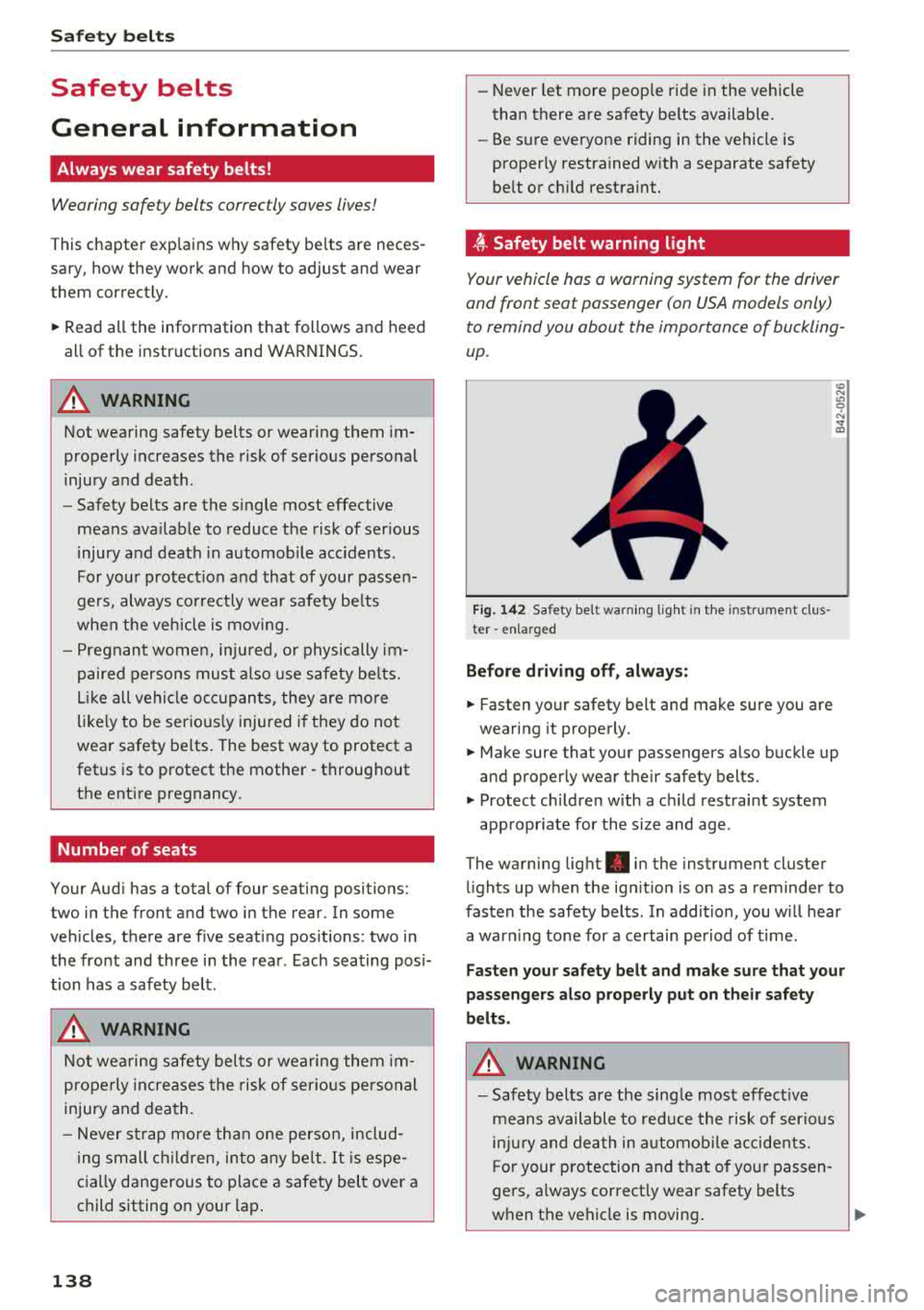
Safety belts
Safety belts
General information
Always wear safety belts!
Wearing safety belts correctly saves lives!
This chapte r exp lains why safety be lts a re neces
sary, how they work and how to adjust and wear
them correct ly.
~ Read all the information that follows and heed
all of t he instr uctions and WARNINGS.
A WARNING
Not wea ring safety belts or wearing them im
properly inc reases the risk of ser io us personal
inju ry and dea th.
- Safety belts are the s ingle most effective
mea ns ava ila bl e to reduce t he ris k of ser ious
injury and dea th in automob ile acc idents.
Fo r yo ur pro tec tion an d that of your passe n
gers, alw ays co rre ctly wea r sa fe ty be lts
whe n the veh icle is mov ing.
- Pr egnan t wome n, in ju re d, o r physically i m
paired perso ns m us t al so use s afety be lts.
L ik e all ve hicl e o ccupa nts, they are mor e
li ke ly to be serio usly i nju re d if th ey d o no t
wea r safety be lts. The best way to protect a
fetus is to protect the mothe r
-th roughout
the ent ire pregnancy.
Number of seats
Your Aud i has a total of four seating positions:
two in the front and two in the rear. In some
ve hicles, there are f ive seating positions: two in
the front and three i n the rea r. Each sea ting pos i
t ion has a safety belt.
A WARNING
Not wearin g s afety bel ts or weari ng the m im
p ro perly in cr eas es th e risk of ser io us person al
inju ry and dea th.
- N ever strap mo re th an on e person, inclu d
i ng sm all childr en, into an y be lt .
It is espe
ci ally d angerous to pla ce a sa fety bel t over a
c h ild sitting o n you r lap .
138 -
Never let more peop le r ide in the vehicle
than there are safety be lts available.
- Be s ure everyone ridin g in t he vehicle is
properly restrained with a separate safety
be lt or c hild restraint.
~ Safety belt warning light
Your vehicle has a warning system for the driver
and front seat passenger (on USA models only)
to remind you about the importance of buckling
up .
Fig. 142 Safety belt wa rning lig ht in th e inst rume nt clus
ter
-e nl arged
Before driving off , always :
~ Fasten yo ur safety belt an d ma ke sure you are
wearing it prope rly.
and properly wea r the ir safety belts.
~ Protect ch ild ren w ith a c hild restraint system
app ropr iate for the size and age .
The wa rning lig ht . in the inst rument cluste r
li ghts up w hen the ig nition is o n as a rem inder to
fasten the safety bel ts . In addi tion, you w ill hear
a war ning tone for a certain period of time .
Fasten your safety belt and make sure that your
passengers also properly put on their safety
belts.
A WARNING -
- Sa fety belt s are th e sing le mo st effecti ve
means av ail able to reduc e the risk of ser ious
in jur y and de ath in a utom obile accide nts.
Fo r your p rotec tion and t hat o f yo ur p ass en
ge rs, a lways cor rect ly wear safety belts
w hen t he ve hicle is moving .
~
Page 143 of 274
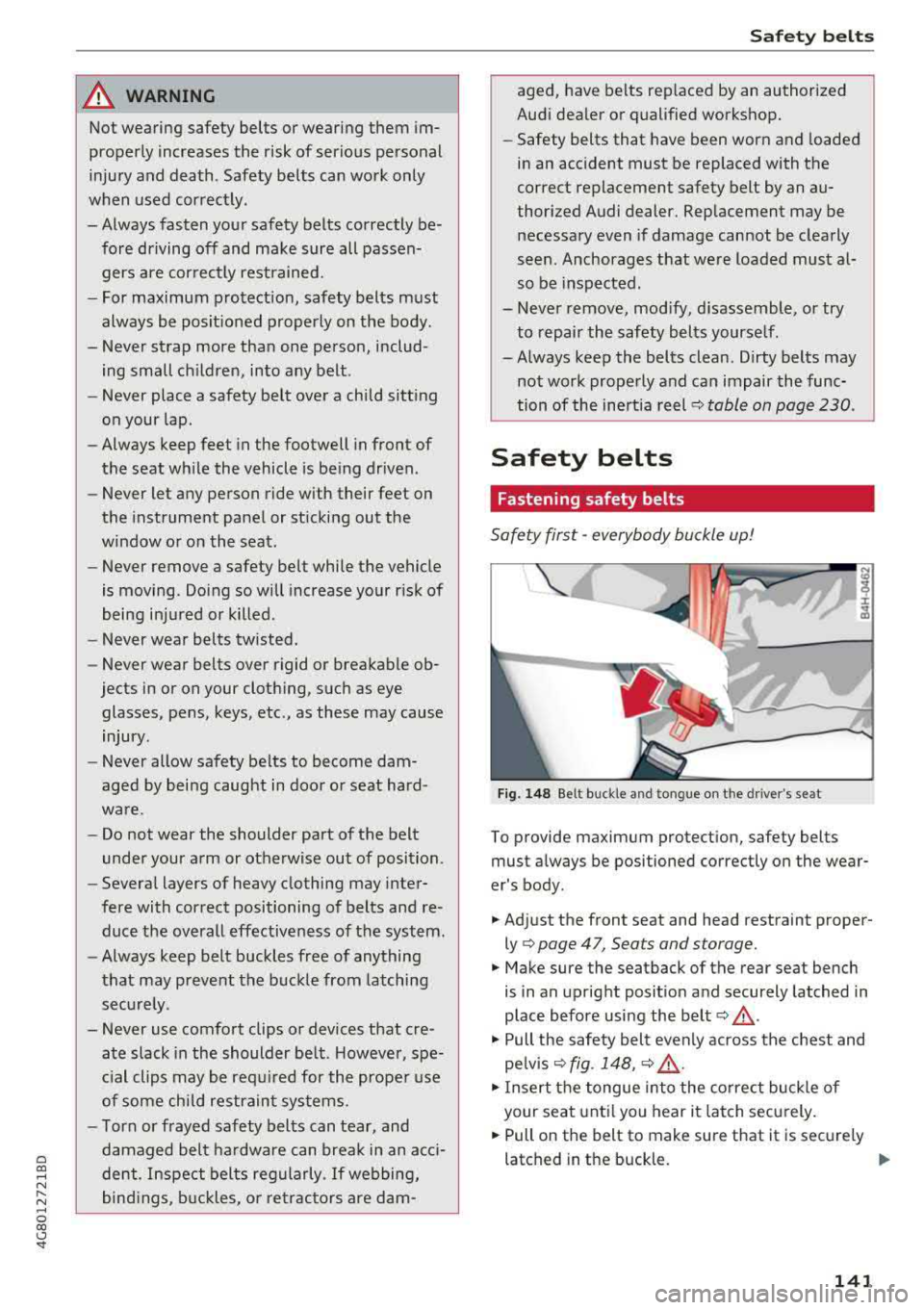
a co ,...,
N
" N ,...,
0 00 <.,;) '
Not wearing safety belts or wearing them im
properly increases the risk of serious personal
injury and death . Safety belts can work only
when used correctly.
-Always fasten your safety belts correctly be fore driving off and make sure all passen
gers are cor rectly restrained.
-For maximum protection, safety belts must
always be posit ioned properly on the body .
-Never strap more than one person, includ
ing small ch ildren, into any belt .
-Never place a safety belt over a child sitt ing
on your lap.
- Always keep feet in the footwell in front of
the seat wh ile the vehicle is being driven.
- Never let any person ride w ith their feet on
the instrument panel or st icki ng out the
window or on the seat.
- Never remove a safety belt while the vehicle
is moving . Do ing so will increase your risk of
being injured or k illed.
- Never wear belts twisted.
- Never wear belts over rigid or breakable ob-
jects in or on your clothing, such as eye
glasses, pens, keys, etc ., as these may cause
injury.
- Never allow safety belts to become dam
aged by being caught in door or seat hard
ware.
- Do not wear the shoulder part of the belt
under your arm or otherwise out of position .
- Several layers of heavy clothing may inter
fere with correct positioning of belts and re
duce the overall effectiveness of the system.
- Always keep belt buckles free of anything
that may prevent the buckle from latching
securely .
-Never use comfort clips or devices that cre
ate slack in the shoulder be lt . However, spe
c ial clips may be requ ired for the proper use
of some child restraint systems.
-Torn or frayed safety belts can tear, and
damaged belt hardware can break in an acc i
dent. Inspect belts regularly .
If webbing,
bind ings, buckles, or retractors are dam-
Safety bel ts
aged, have belts rep laced by an authorized
Aud i dea ler or qualified workshop.
- Safety belts that have been worn and loaded
in an accident must be replaced with the
correct replacement safety belt by an au
thor ized Audi dealer. Replacement may be
necessary even if damage cannot be clearly
seen. Anchorages that were loaded must al
so be inspected.
- Never remove, mod ify, d isassemble, or try
to repair the safety belts yourse lf.
-Always keep the belts clean . Dirty belts may
not work properly and can impair the func
tion of the inert ia reel
q table on page 230 .
Safety belts
Fastening safety belts
Safety first -everybody buckle up!
Fig. 148 Be lt buckle and to ngue on t he d river' s se at
To provide maximum protection, safety belts
must always be positioned correctly on the wear
er 's body .
.. Adjust the front seat and head restra int proper
ly
q page 47, Sea ts and storage.
.. Make sure the seatback of the rear seat bench
is in an upright posit ion and securely latched in
p lace before using the belt
q ,&. .
.. Pull the safety belt evenly across the chest and
pe lvis
q fig . 148, q ,&. .
.. Insert the tongue in to the correct buckle of
your seat until you hear it latch securely.
.. Pull on the belt to make sure that it is securely
latched in the buckle.
..,
141
Page 148 of 274
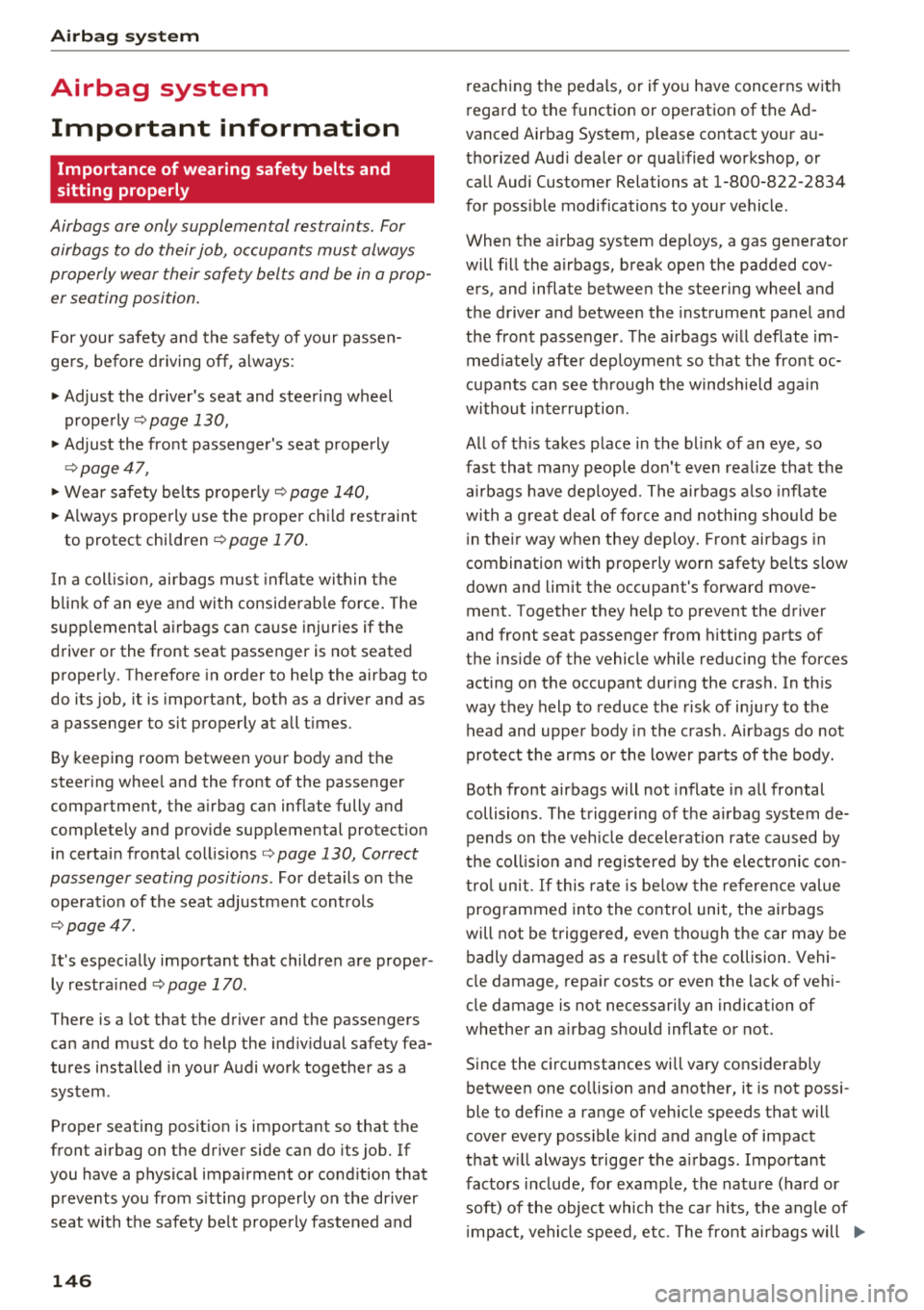
Airbag system
Airbag system
Important information
Importance of wearing safety belts and
sitting properly
Airbags are only supplemental restraints . For
airbags to do their job, occupants must always
properly wear their safety belts and be in a prop er seating position.
For your safety and the safety of your passen
gers, before driving off, always:
.,. Adjust the dr iver's seat and steering wheel
properly~ page 130,
.,. Adjust the front passenge r's seat properly
~page 47 ,
.,. Wear safety belts properly~ page 140,
.. Always properly use the proper child restraint
to protect chi ldren
~page 170 .
In a coll is ion, airbags must inflate within the
blink of an eye and with considerable force. The
supp lemental airbags can cause injuries if the
driver or the front seat passenger is not seated
properly. Therefore in order to he lp the airbag to
do its job, it is important, both as a dr iver and as
a passenger to sit properly at all t imes.
By keeping room between your body and the
steering whee l and the front of the passenger
compartment, the air bag can inflate fully and
completely and provide supplemental protect ion
in certain frontal
coll isions¢ page 130, Correct
passenger seating positions .
For details on the
operation of the seat adjustment controls
¢ page 47.
It's especially important that children are proper
ly restrained
¢ page 170.
There is a lot that the driver and the passengers
can and must do to help the ind iv idual safety fea
tures installed in your Audi work together as a
system.
Proper seating posit ion is important so that the
front airbag on the driver side can do its job. If
you have a physical impairment or cond ition that
prevents you from s itting properly on the driver
seat with the safety be lt properly fastened and
146
reaching the pedals, or if you have concerns with
regard to the function or operation of the Ad
vanced Airbag System, please contact your au
thorized Audi dea ler or qualified workshop, or
ca ll Audi Customer Relations at 1-800-822-2834
for poss ible modifications to your vehicle .
When the airbag system dep loys, a gas generator
will fill the airbags, break open the padded cov ers, and infla te between the steering wheel and
the driver and between the instrument panel and
the front passenger. The a irbags w ill deflate im
med iate ly after deployment so that the front oc
cupants can see through the windsh ield aga in
without interruption.
All of th is takes place in the blink of an eye, so
fast that many people don't even realize that the
a irbags have deployed. The airbags also inflate
with a great deal of force and nothing should be
in the ir way when they deploy. Front airbags in
combination with properly worn safety belts slow
down and limit the occupant's forward move
ment. Together they help to prevent the driver
and front seat passenger from hitting parts of
the ins ide of the vehicle while reduc ing the forces
acting on the occupant dur ing the crash . In th is
way they help to reduce the risk of injury to the
head and upper body in the crash . Airbags do not
protect the arms or the lower parts of the body.
Both front airbags will not inflate in all frontal
collisions. The triggering of t he a irbag system de
pends on the veh icle deceleration rate caused by
the collis ion and registered by the electronic con
trol unit. If this rate is be low the refe rence value
programmed into the control unit, the airbags
will not be triggered, even tho ugh t he car may be
badly damaged as a resu lt of the co llision . V ehi
cle damage, repair costs or even the lack of vehi
cle damage is not necessarily an indication of
whether an a irbag should inflate or not.
Since the circumstances wi ll vary considerab ly
between one co llision and another, it is not possi
ble to define a range of veh icle speeds that will
cover every poss ible kind and angle of impact
that w ill always trigger the airbags. Important
factors include, for example, the nature (hard or
soft) of the object which the ca r hits, the angle of
im pact, vehicle speed, etc. The front airbags will
..,.
Page 149 of 274
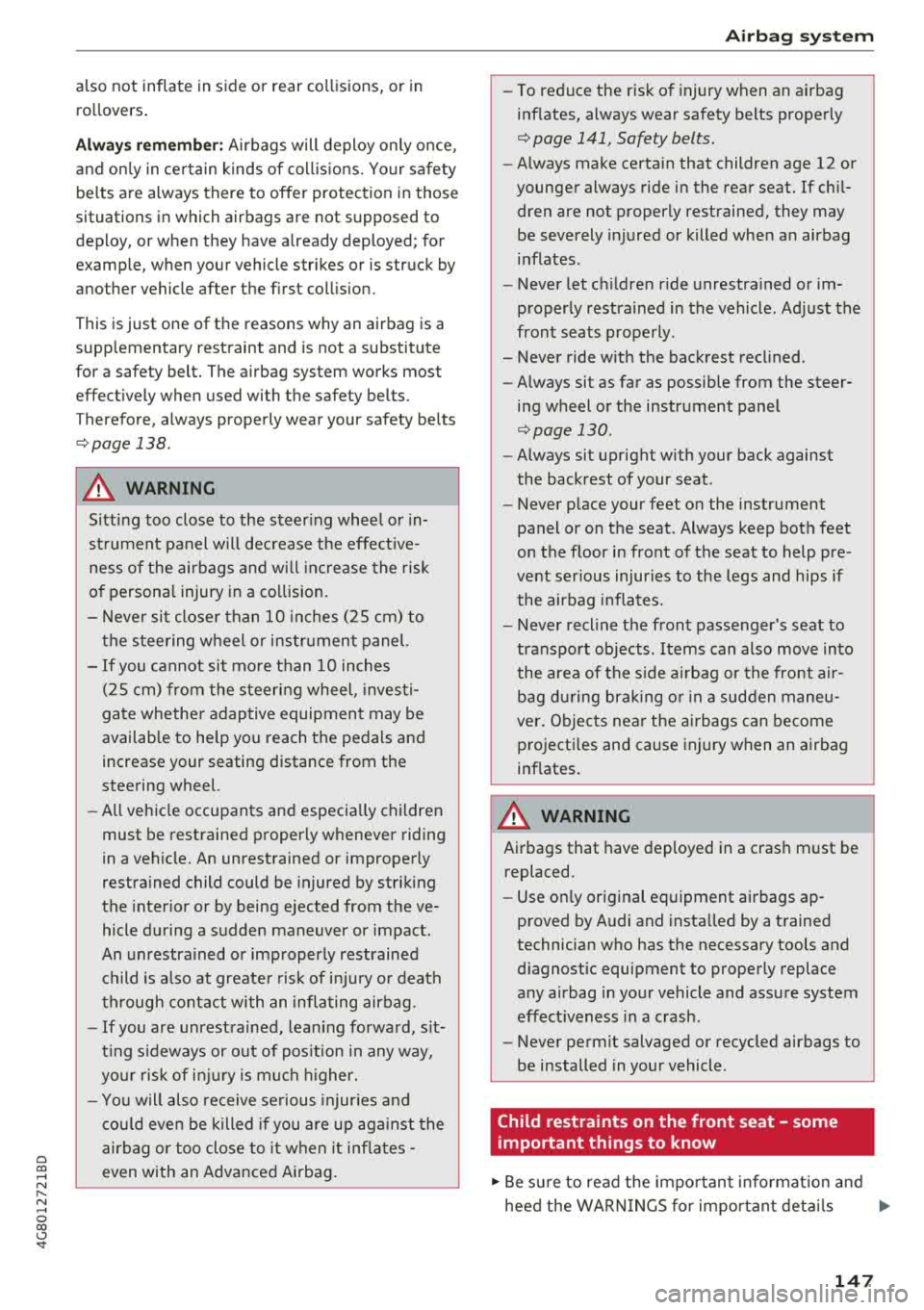
a co .... N
" N .... 0 00 \.J '
ro llovers .
Always re memb er: Airbags will deploy only o nce,
and on ly in ce rtain k inds of coll is ions. Yo ur safety
be lts are always there to offer protection in those
situations in which airbags are not supposed to
deploy, or when they have already deployed; for
examp le, when your vehicle str ikes or is struck by
another vehicle after the first coll is ion.
This is just one of the reasons why an airbag is a
supp lementary restraint and is not a substitute
for a safety belt. The airbag system works most
effect ively when used with the safety belts.
Therefore, always properly wear your safety belts
<=:> page 138 .
A WARNING
Sitting too close to the steer ing whee l o r i n
st rument panel w ill decrease the effe ct ive
ness of the airbags and will inc rease the risk
of persona l injury in a co llision.
- Never si t close r than 10 inches (25 cm) to
the stee ring w heel or instr ument panel.
- If you cannot sit mo re than 10 inches
(25 cm) from the s teeri ng wheel, invest i
gate whethe r adaptive equipment may be
availab le to he lp you reach the pedals and
increase your seating distance from the
steering wheel.
- All ve hicle occupants and especia lly children
must be restrained proper ly whenever riding
in a vehicle. An unrestrained or improperly
restra ined child could be injured by striking
the interior or by being ejected from the ve
hicle during a sudden maneuver or impact.
An unrestra ined o r imp roperly restrained
c hild is also at greate r risk of inju ry o r death
t h rough contact with an inflating airbag.
- If you are unrestrained, lean ing fo rwa rd, s it
ti ng s ideways or o ut of pos it ion in any way,
yo ur risk of i njury is m uch higher.
- Yo u will also receive se rious injur ies and
c ou ld eve n be killed if you are up aga inst the
air bag o r too close to it w hen it in flates -
even with an Advanced Airbag.
-
Airbag syste m
-To reduce the r is k of injury when an airbag
inf lates, always wear safety belts prope rly
<=:> page 141, Safety belts.
- Always make certain that children age 12 or
younge r always ride in the rear seat. If chil
dren are not properly restrained, they may be severely injured or killed when an airbag
i n flates.
- Never let c hildren r ide unrestra ined or im
properly restrained in the vehicle . Ad just the
front seats properly.
- Never ride w ith the backrest recl ined .
- Always sit as far as possible from the steer-
ing wheel or the instrument pane l
<=:> page 130.
-Always sit upright w ith your back against
the backrest of your seat .
- Never p lace your feet on the instrument
panel or on the seat. Always keep bot h feet
on the floor in front of t he seat to help pre
vent ser ious injur ies to the legs and hips if
the airbag inflates.
- Never recl ine t he fron t passenger's seat to
transpo rt objects . Items can also move into
the area of the s ide airbag or the front air
b ag d uring brak ing o r in a sudden ma neu
ve r. Obje cts near the a irbags can be come
p rojecti les and cause injury when an airbag
inf lates .
A WARNING ,..__ -
Airbags that have deployed in a cras h m ust be
replaced.
- Use on ly original eq uipment airbags ap
proved by A udi and insta lled by a trained
technician who has the necessary tools and
d iagnostic equipment to properly replace
any airbag in yo ur vehicle and assure system
effect iveness in a crash.
- Never permit salvaged or recycled airbags to
be installed in you r vehicle.
Child restraints on the front seat - some
important things to know
.. Be s ure to read the impo rtant info rmat io n and
heed the WARN INGS for important deta ils
147
Page 150 of 274
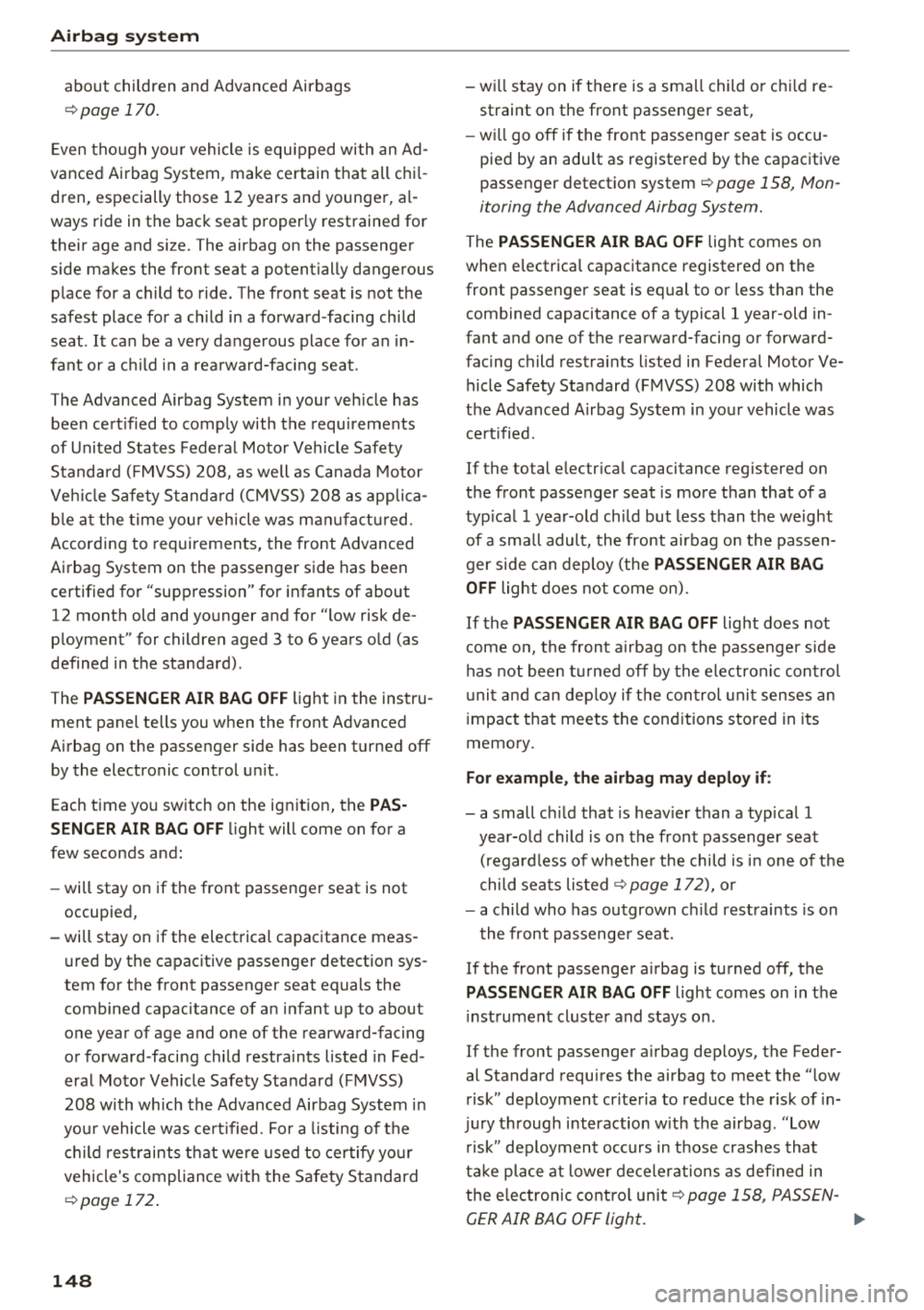
Airbag syste m
about children and Advanced Airbags
¢page 170 .
Even tho ugh yo ur vehicle is equ ipped with an Ad
vanced Ai rbag System, make certain that all chi l
dren, especially those 12 years and younger, al
ways ride in the back seat properly restrained for
their age and size. The airbag on the passenger
side makes the front seat a potentially dangerous
place for a child to ride. The front seat is not the
safest place for a child in a forward-facing child
seat . It ca n be a very dangerous place for an in
fant or a c hild in a rea rwa rd-fac ing seat.
The Advanced Airbag System in your veh icle has
been cert ified to comply with the requ irements
of United States Federal Moto r Vehicle Safety
Standard ( FMVSS) 208, as well as Canada Motor
Ve hicle Safety Standa rd (CMVSS) 208 as applica
b le at the time your veh icle was ma nufactu red.
Acco rding to requi rements, the front Advanced
Airbag System on the passenger side has been
certifi ed for "suppression" for infants of about
12 month old and younger and for "low risk de
p loyment" for children aged 3 to 6 years o ld (as
defined in the standard) .
Th e
PASSENGER AIR BAG O FF light in the instru
ment panel tells you when the front Advanced
Airbag on the passenger side has been turned off by the electronic control un it .
Each time yo u switch on the ignition, the
PAS·
S ENGER AIR BAG OFF
light will come on for a
few seconds and:
- will stay on if the front passenger seat is not
occupied,
- will stay on if the electrical capacitance meas
u red by the capacitive passenger detection sys
tem for the front passenger seat equals the combined capacitance of an infant up to about
one year of age and one of the rearward-facing
or forward-facing child restraints listed in Fed
eral Motor Vehicle Safety Standard (FMVSS)
208 with wh ich the Advanced Airbag System in
yo ur vehicle was ce rt ified. For a listing of the
c hi ld rest raints t hat we re used to ce rtify yo ur
vehicle 's compliance with the Safety Standard
¢ page 172 .
148
-w ill stay on if there is a sma ll child o r chil d re
straint on the front passenger seat,
- w ill go off if the front passenger seat is occu
pied by an adu lt as registered by the capacitive
passenger detection system ¢
page 158, Mon
itoring the Advanced Airbag System.
The PASSENGER AIR BAG OFF lig ht comes on
when e lectrica l capacitance registered on the
front passenger seat is equal to or less t han the
combined capacitance of a typical
1 year-old in
fant and one of the rearward-facing or forward
facing child restrai nts listed in Federa l Motor Ve
hicle Safety Standard (FMVSS) 208 with which
the Advanced A irbag System in yo ur vehicle was
ce rt ified.
If the to tal e lectr ica l capacitance registered o n
the front passenger seat is more than that of a
typ ical 1 yea r-old ch ild but less than the weight
of a sma ll adult, the front airbag on the passen
ger side can deploy (the
PASSENGER AIR BAG
OFF
light does no t come on).
If the
PASSENGER AIR BAG OFF light does not
come on, the front airbag on the passenger s ide
has not been turned off by the electroni c con trol
u nit a nd can dep loy if the con trol unit senses an
i mpact t hat meets the cond itions stored in its
memory.
For exampl e, the airbag ma y deplo y if:
- a small ch ild that is heav ier than a typ ical 1
year-old child is on the front passenger seat (regard less of whethe r the child is in one of t he
child seats listed
¢ page 172), or
- a child who has outgrown c hild rest raints is on
the front passenge r seat.
If the front passenger a irbag is turned off, the
PASSENGER AIR BAG OFF light comes on in the
i nst rument cluster and stays on .
If the front passenger a irbag deploys, the Feder
al Standard requires the airbag to meet the "low
risk" deployment cr iteria to reduce the r isk of in
j u ry th rough interact ion w ith the airbag .
"Low
risk " dep loyment oc curs in t hose crashes tha t
t a ke place at lowe r decele ra tions as defined in
t h e e lec tronic co ntro l unit
¢ page 158 , PASSEN-
GER AIR BAG OFF light.
..,_